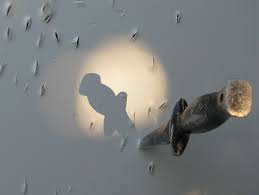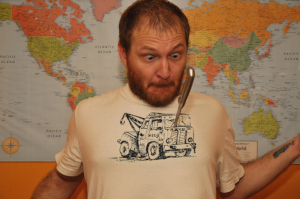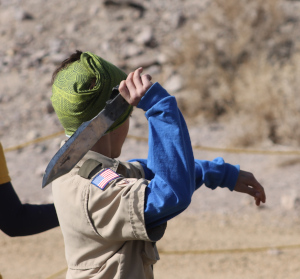How to Throw a Knife
There is nothing more satisfying than being able to throw a knife and have it stick to its target while others cannot seem to do it. You have seen it done in the movies for many years. Now it is your time to learn how this is done. In this article, we will teach you how to properly throw a knife and be the envy of your friends! Or better yet maybe you will want to enter in knife-throwing competitions.

Type of Knife to Use
Did you know that each different type of knife needs to be thrown in a different way? Depending upon the knife you will have to use a different grip on the handle and how you release it will be different with each knife you throw.
The best-throwing knife will need to have a sharp tip that is thick and strong enough so that it won’t bend when it hits its target. The knife should have a solid blade with no holes or perforations to minimize the chances of breaking. Also, the knife should have rounded edges and dull edges for safety’s sake. The ideal weight should be about 7 to 8 ounces for balance. If you have a knife that is lighter than that then your throwing accuracy has to be better so for this tutorial as a beginner use a knife that is at least 7 to 8 ounces.
For obvious reasons, a folding pocket knife would be a poor choice of knife to throw. It would fold back into itself if it doesn’t hit the mark exactly.
What Target to Use for Practice
The best target to use when you are first learning to throw a knife is a large soft target like an old rotting tree. If you pick something rock-hard the chances of the knife bouncing back and hitting you increase ten-fold and for the people out there that have no common sense make sure that the area behind the target is free of people, the neighbor’s cat, or your car. With a large soft target like a tree stump, you can work on getting your throwing method down pact first and then work on accuracy, speed, and power later on.
It would be a good idea to let someone know that you are practicing throwing knives just in case you get hurt.

What to Wear
Earlier we talked about the dangers of the knife bouncing back at you so it would be a good idea to wear something to protect you while you are practicing like steel-toed boots and thicker clothing like leather or denim.
What Stance and Grip to Use When Throwing a Knife
Your stance should be relaxed so that you have more control over the accuracy of the throw. Being tense makes your knife go to unexpected places like the squirrel up the tree. You will also notice that the knife will not consistently be thrown to the same location if your body is tense.
Having good posture by standing up straight will also help you reach your target better as well as maintain better control of your throw. If you are right-handed you will want to have your right foot out slightly ahead of your left foot. If you are left-handed then you will want your left foot slightly ahead of your right foot. Then make sure that both of your arms are straight and pointing toward the target not veering to the left or right.
Do you know how you grip a hammer? That is the same grip that you will want to use when holding a knife that you want to throw that is blade-heavy. This means keeping your thumb on top of your other fingers and keeping notes on the placement of your fingers so that they are all in a line and are parallel to each other. If they are not in line with each other then the angle of the throw will be off.
If you are throwing a knife that is heavier on the handle then you will want to hold the knife by the blade when you throw it with your thumb on one side of the blade following the spine and pointing toward the handle and the other fingers lined up on the other side of the blade curved and not lying flat against the blade. Of course, the sharp part of the blade will be pointing away from the palm of your hand instead of resting against it.
If you are throwing a handle-heavy knife that is double-bladed (sharp edge on both sides) then you will have to grip the blade differently. Remember how you curved your fingers on the single-bladed knife without resting them on the blade? You do the same thing with a double-bladed knife with the fingers but you would also do that with the thumb instead of resting it on the blade like on a single-blade knife.
Notes: Wikihow.com has excellent animated images that show how the knife is thrown.
Different Kinds of Ways to Throw a Knife
When you throw a blade-heavy knife and hold it by the handle it will need to spin in the air at least once for more accuracy. When you throw a handle-heavy knife and hold it by the blade then you will need to spin it at least 1 ½ times for the most accuracy.
Below, we will show you how to start out with a ½ rotation throw, then when you get comfortable with that show you how to do a full rotation throw.

Half-Rotation Throw
The first way to learn is to use a half-spin and for this, you will need to be about 6 feet away from your target but depending upon your height, knife, and throwing technique this can be longer or shorter than 6 feet away. You start out holding the knife with the blade pointing straight up into the sky and then as your arm goes back the handle will be facing forward and pointing upward at about a 45-degree angle while the blade will be pointing backward and downward at about 45 degrees. When you bring your arm forward, release the knife about ¾ extension of your arm, and if all goes well the knife will be pointing straight up in the air about halfway to the target and pointing perfectly at the target when it reaches its destination.
Do not try to throw the knife hard at first because it can screw up the rotation of the throw. To start out with, just give a medium throw until you get the ‘feel’ for it. Be sure to follow through when you release the knife for more accuracy.
Full-Rotation Throw
Once you master doing the half-rotation throw and can get it to stick in its target every time it will be time to do the harder full-rotation throw that requires more accuracy.
Since we are doing a full rotation instead of a half rotation you will need to be farther away from your target like 10 to 11 feet away.
Be sure to use the correct stance when throwing the knife and be aware of your surroundings!
You hold the knife the exact same way as you held it for the half-rotation throw. You start out holding the knife with the blade pointing straight up into the sky and then as your arm goes back the handle will be facing forward and pointing upward at about a 45-degree angle while the blade will be pointing backward and downward at about 45 degrees. When you bring your arm forward, release the knife about ¾ extension of your arm. The knife will need to make a full rotation before hitting its target so when you are practicing throwing the knife make note of where your arm position is when throwing the knife and whether you have to move closer or farther away from the target. When you get to a distance that is comfortable and gets you the most hits on the target, make note of how far away you are from the target so that you will know your comfort zone.
Since this throw requires more accuracy you will need to make sure that your stance is correct and that you throw at medium pressure until your accuracy improves. Be sure to follow through when you release the knife for more accuracy.
No-Spin Throw
Despite what the popular name is the knife actually spins a ¼ of a turn and is best used with a professionally balanced knife.
A no-spin throw requires you to be much closer to the target about ½ of the distance that you would use in a half-rotation throw. You would adopt the same stance as in the other throws but you will be gripping the knife differently this time.
With a balanced knife, you would hold the knife by the handle between your thumb and the second knuckle of your middle finger. Your index finger should be laying along the back edge of the handle while curling the rest of your fingers over.
When throwing the knife you follow the same procedure as above but instead of bending at the elbow when you throw you bend at the shoulder to keep the blade from rotating as much. Follow through like before but this time you step forward at the same time to gain more accuracy and less rotation in your throw.
Tips and Tricks
Once you get your accuracy down pact you can practice throwing the knife harder and with more force. Once you can stick it into the soft target constantly throwing this way you can practice by throwing it into a harder target.
There will be a time when you practice enough it will become second-hand and you will not have to think about how to throw too much. To keep in this mode of throwing you will have to practice every now and then so that you will not lose that automatic feeling. Remember, if you don’t use it you will lose it!
After you are done practicing throwing your knife be sure to clean it off and sharpen it.
Type of Knives we have for sale below:
Hunting Knives | Fillet Knives | Bowie Knives | Camping Knives | Drop Point Knives | Fixed Blades | Skinner Knives | Fin and Feather
Pocket Knives
Pocket Knives | Boy Scout Knives | Folding Knives | Yooper Knives
Custom Knives
Custom Knives | Damascus Knives | Engraved Knives
Kitchen Knives
Kitchen Cutlery | Knife Sets
Axes
Mini Axes | Redi-Axes | Other Axes
Sharpeners
Redi-Edge Sharpeners
Our Gift Shop
Hats | Clothing | Jewelry | Artwork | Drinking Items | Flashlights | Miscellaneous